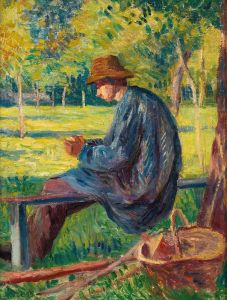
Pont Aux Environs D’angers
A hand-painted replica of Maximilien Luce’s masterpiece Pont Aux Environs D’angers, meticulously crafted by professional artists to capture the true essence of the original. Each piece is created with museum-quality canvas and rare mineral pigments, carefully painted by experienced artists with delicate brushstrokes and rich, layered colors to perfectly recreate the texture of the original artwork. Unlike machine-printed reproductions, this hand-painted version brings the painting to life, infused with the artist’s emotions and skill in every stroke. Whether for personal collection or home decoration, it instantly elevates the artistic atmosphere of any space.
Maximilien Luce's painting Pont Aux Environs D’Angers (translated as "Bridge in the Vicinity of Angers") is a work by the French Neo-Impressionist artist, known for his contributions to the Pointillist movement. Luce, born in 1858 in Paris, was a prominent figure in late 19th and early 20th-century art, particularly associated with the techniques of Pointillism and Divisionism, which were pioneered by Georges Seurat and Paul Signac. These techniques involve the application of small, distinct dots of color to create an image, relying on the viewer's eye to blend the colors optically.
The painting depicts a serene landscape featuring a bridge near Angers, a city in western France known for its historical and architectural significance. The scene captures the tranquil beauty of the French countryside, with the bridge serving as a focal point amidst the natural surroundings. Luce's use of light and color in this work reflects his mastery of Neo-Impressionist techniques, as he skillfully conveys the atmosphere and mood of the setting.
Luce was deeply influenced by the social and political movements of his time, and his works often reflect a sense of humanity and connection to everyday life. While Pont Aux Environs D’Angers primarily focuses on the landscape, it also demonstrates Luce's ability to infuse his art with a sense of harmony and balance, characteristic of his broader oeuvre.
The exact date of the painting is not definitively documented, but it is consistent with Luce's mature period, during which he frequently explored themes of rural and urban landscapes. His works from this time often highlight the interplay between human-made structures and the natural environment, as seen in this depiction of a bridge integrated into the surrounding countryside.
Luce's artistic career was marked by his commitment to both aesthetic innovation and social ideals. He was an active member of the anarchist movement and used his art to express his beliefs, though Pont Aux Environs D’Angers appears to focus more on the aesthetic and technical aspects of his craft rather than overt political commentary.
Today, Maximilien Luce's works are celebrated for their technical brilliance and emotional depth. Pont Aux Environs D’Angers is a testament to his ability to capture the essence of a place through his distinctive Neo-Impressionist style. The painting is part of the broader legacy of Luce's contributions to the art world, which continue to be studied and admired by art historians and enthusiasts alike.

















